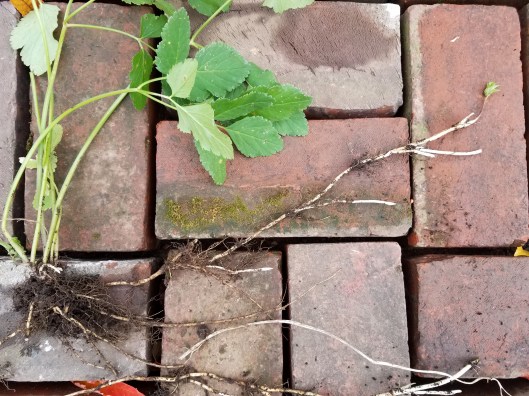Last week, I asked What might be called “the scourge of Gaiety Hollow”? It was less than 12 hours before someone guessed correctly:
Aegopodium podagraria
Also known as ground elder, bishop’s weed, gout weed, snow-on-the-mountain, English masterwort, and many indecent names that a gardener calls it in a fit of fury.
There are two varieties of Aegopodium. One has green leaves; the other has variegated white/green leaves. In my experience, they are equally aggressive. They both bloom in the summer a rather unremarkable umbel-shaped flower similar to Queen Anne’s lace. This late in the season, Aegopodium is still lush and green.

Covering the base of a Hydrangea
Portland includes it on its Nuisance Plant List. Although it is considered less aggressive than many other plants in native ecosystems, it is extremely aggressive in a garden setting and (almost) impossible to get rid of. Volunteers have spent countless hours pulling it out of the plant beds at Gaiety Hollow and yet it keeps coming back. Its roots are well entwined with the boxwood hedges making complete eradication unlikely, but we can at very least keep it from getting out of control again.

Mother plant on the left. A new plant growing from the rhizomes to the right.
If you have Aegopodium in you garden, I would advise you to remove it as quickly as possible. Most likely you will not get all of it out. A fragment of its white rhizomes left underground will regrow. Even if you think that you like it, begin removing it now to keep it under control.
Like the other weeds I have mentioned, digging seems the best way to go in a garden setting. I dig with a shovel or trowel and follow the roots through the garden bed, gently pulling the plants and roots as I go. I try not to break the plants and feel very satisfied if I can pull up roots more than a foot long at a time. If it is growing into the roots of a perennial, I face the choice of bare-rooting the perennial or pitching it altogether.

Another example of how the plant spreads by underground “runners” (rhizomes)
However, if you have a large patch of Aegopodium with no other desirable broadleaf plants mixed in, applications of an herbicide might take down the population. Always read the label on herbicides to make sure that you are applying the right product, at the right amount, in the most opportune conditions.

Aegopodium in Dahlias
Can you see the white Aegopodium root extending to the left? It is growing straight through this clump of Dahlia tubers. I planted the Dahlia earlier this year as a single tuber, so the Aegopodium has grown over 2 feet in one season. I will have to divide this group of tubers to remove the Aegopodium. I don’t want to risk accidentally re-planting the Aegopodium come spring. Constant vigilance is key! Again, a fragment of root left alive will regrow and quickly begin taking over.
I have many other hated weeds, but these are our biggest challenges at both Gaiety Hollow and the historic gardens at Deepwood. What is your least favorite weed?
We are very grateful for the many hours of labor our dedicated volunteers have put into removing these weeds. The gardens would be a jungle without their help.



I have to say scotch broom, which I really dislike. Too bad it’s not a food crop. We could solve Oregon’s hunger issues!
Good one. We don’t have it in the L&S gardens, but it is certainly a problem in larger landscapes. It’s on Portland’s Nuisance Plant List.
English Ivy!
Absolutely! I called the people that handle the City compost and they said NOT to put ivy seeds in the compost. Even after 6 months at 140-160F, the seeds still germinate. The vines are fine, but not if they have seed heads on them. Those go in the trash.
The weeds with the pesky entangling breaking-off roots are the worst, aren’t they?
Yes! I suppose that’s why they are so successful. I thought I had the weeds under control and then I made the mistake of looking at the west side of the property…